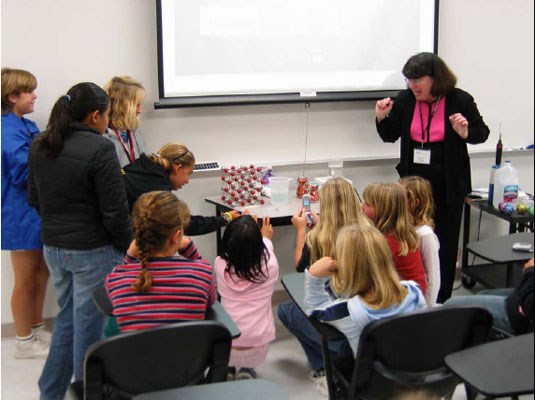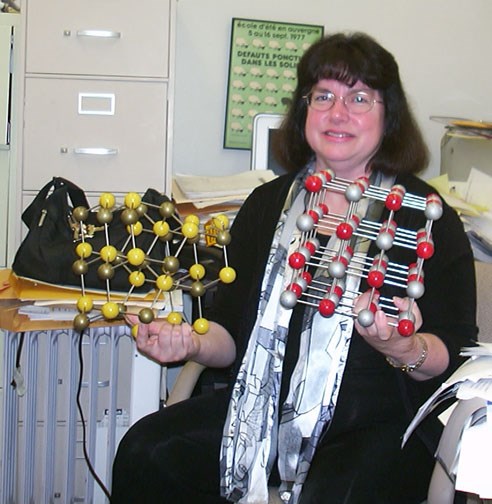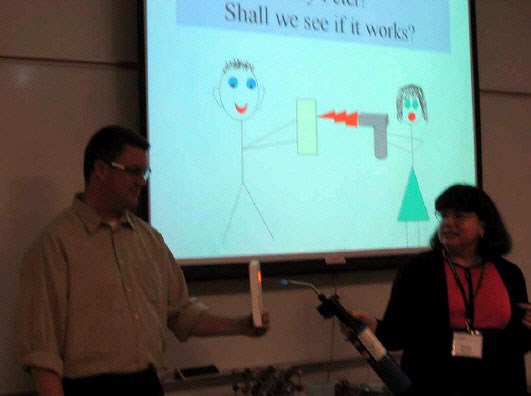 |
| Martha Mecartney doing a demo for young girls. (Martha Mecartney) |
It was Sally Ride Science Day at the University of California, Irvine (UCI), where the famous astronaut was appearing at a festival to interest young women in science. In a nearby classroom, Professor Martha Mecartney and her graduate students prepared a demonstration with a superconductor - a ceramic made of the elements yttrium, barium, copper and oxygen, which, when it gets very cold, can transmit electricity without any resistance. To activate the superconductor, Professor Mecartney poured liquid nitrogen over it, and the current flowed through. When she put a magnet on top of the superconductor, the magnet levitated half an inch in the air above the frigid superconductor.
Watching the demonstration, a group of ten- to twelve-year-old girls squealed and cheered when the magnet lifted off the superconductor, and several of them excitedly took pictures with their cell phones. They were living in a moment of joy and inspiration brought to them by science. That moment was made possible by Professor Mecartney. She has devoted her career not only to creating exotic materials, but also to bringing science to young women and other groups underrepresented in the sciences. She has tried to get young women to become scientists and engineers, by providing them with the opportunities and support they need to survive in the discipline. The story of how she started in science, with help from her own teachers and mentors, is inspirational.
 |
| Professor Martha Mecartney in her office. (Jonathan Cohen) |
Martha Mecartney is a scientist, engineer, and professor in UCI’s School of Engineering. She works on ceramics, but doesn’t throw pottery or make coffee mugs. She makes materials that do amazing things, like the ceramic tiles on the space shuttle, which absorb 30,000 degrees of heat on their outside, but are completely cool on their inside, protecting the astronauts from roasting to death. There are not many women in engineering, and Martha had to be heroic to get where she is today. Her teachers and mentors gave her a lot of help; today, she’s giving it back to her students and to schoolchildren.
 |
| Martha Mecartney blasting heat onto shuttle tiles (Martha Mecartney) |
Martha Mecartney comes from the small town of Bluffton, Ohio, which, when she was a child, had around 2,000 people. Her high school graduating class had only ninety-two students. Martha was bright but didn't get straight As. Three sets of teachers really inspired her, though: her math, science and Latin teachers, whose classes opened up worlds to her. She fell in love with mathematics, especially algebra and topology; the physical sciences (chemistry and physics); and with classical civilization - the lives of ancient Greeks and Romans. In college, at Case Western Reserve University, she struggled in the first-year math and science courses. In high school, she had been the smartest person in her class, and had graduated as valedictorian; now at Case, she was hanging out with valedictorians from bigger, better high schools. Martha was continually questioning herself, and she thought her B and C grades were the equivalent of failing. In college, (and again later in graduate school) "the dumb ones had left, leaving only the smartest" to compete with. Although she was not living her dream of easy perfection, each time she doubted herself, a professor or mentor stepped in and guided her. They saw something in her that made them persuade her to stay. They gave her good advice. For example, although she had excelled in classics, the study of ancient Greece and Rome, her college classics professors told her not to go to graduate school in classics because that field had no jobs. When she looked around for a second major, she found a small department, Metallurgical Engineering and Materials Science, whose faculty encouraged her to come back to the sciences.
The department was grateful to have her - there was such a shortage of metallurgical engineers that they offered to replace her student loans with scholarships. They told her that her math and science grades weren't "bad" after all - they were just science grades at a tough institution. And the small department was able to provide individual attention and an opportunity to work on research on materials. Martha liked the subject; she was fascinated by materials like glass, which, unlike crystalline materials (for example, diamonds), is an amorphous, shapeless substance that "flows" at phenomenally slow rates of speed. An entire class about glass piqued her interest and spurred her to study other ceramic materials.
Even a seeming rejection helped to guide her. A few months before she was to graduate from Case Western Reserve, she interviewed with IBM, hoping to get a job designing new materials. She told one of her interviewers on a plant trip to San Jose, California, that she wanted to help design new materials, especially for technical ceramics. The professional replied to her that with a B.S. in metallurgical engineering and materials science, she would be rebuilding furnaces and doing other low-level technical activities. To design materials, Martha would have to get a Ph.D. Taking that good advice, she went to Stanford, and later became a professor at the University of Minnesota and the University of California, Irvine.
A major part of Martha's career in science and engineering has centered around ceramics. Traditionally, you think of ceramics as being brittle, like a coffee mug. You drop a coffee mug on the floor and it breaks. It's not very "ductile" - it cannot be molded or worked. But Martha has found a way to design the molecular structure of these materials so that, at a high temperature, you can deform, shape, mold, and squeeze them without the ceramic breaking. Then you can cool the ceramic part to room temperature, and the piece will be perfectly formed. That's much better than going to a machine shop and trying to shape it with a lathe or a drill, which could crack or break it. These new ceramic materials are called "superplastic ceramics," and have attracted the interest and support of the National Science Foundation.
An important tool in characterizing these kinds of new materials is the electron microscope, and Martha has pioneered the use of different kinds of electron microscopes over her years in science. These microscopes show the structures of molecules down to individual atoms, and how the atoms are arranged in regular crystals called "grains."You can see that while a coffee mug's material has large and irregular grains, Martha's new materials have very small uniformly shaped grains that can slide over one another and enable the material to change shape when heated.
But if all Martha did was science and engineering, she would not be the hero that she is. Over her eighteen years at UCI, she has given back to a generation of students what she received from her own mentors: support for students' interest, studies, and careers in science. If you put into a bowl all the names of all the programs to help students she either founded or led, it would be a very large bowl of alphabet soup. Martha had several goals with these programs. First, she wanted not only to identify students with an interest in science and engineering, but to find students from families who had never sent a child to college, from families who because of their culture or poverty never would have dreamed their child could have a future as a scientist or engineer, and show them that science and engineering could be challenging and fascinating without being intimidating. Second, Martha wanted to support these students through getting to know them personally. Third, she found financial support to strengthen their backgrounds and classroom knowledge, and enable them to conduct their own research over the summer, do research at other universities in the University of California system, and bond with each other, creating a community of young scientists who kept in touch with each other through the rigors of graduate school and beyond. Finally, she made a place for especially promising materials science and engineering students in her own laboratory, where they could work on corners of some of the discipline's most significant problems. Some of her students are now important scientists and engineers themselves, some are faculty at universities across the world, and some have pursued careers in industry, where they make significantly more money than she does.
 |
| Martha Mecartney at PAESMEM Awards Ceremony |
In 2003, to recognize her work mentoring students, Martha Mecartney was awarded the 2002 Presidential Award for Excellence in Math, Science, and Engineering Mentoring, conferred by President George W. Bush. This highest of awards honors her contributions to her discipline and to our country. But it was not the culmination of Professor Mecartney’s work; she continues to make important discoveries and to be a quiet hero to students, encouraging them to discover their own potential.
Update 2013: UCI - American Ceramic Society Names Professor Martha Mecartney a Fellow.
Page created on 7/29/2013 1:12:24 PM
Last edited 1/9/2017 10:37:53 PM
